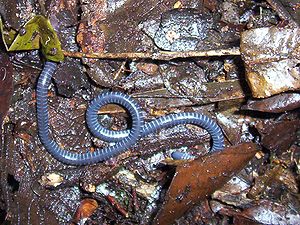Boulengerula
| Boulengerula | ||||||||||||
|---|---|---|---|---|---|---|---|---|---|---|---|---|

|
||||||||||||
| Systematics | ||||||||||||
|
||||||||||||
| Scientific name | ||||||||||||
| Boulengerula | ||||||||||||
| Tornier , 1896 |
Boulengerula is a genus from the family of herpelidae in the order of Caecilian (Gymnophiona). They are worm-like amphibians without limbs and with a severely receded tail. The generic name honors the British zoologist George Albert Boulenger .
features
In contrast to the second genus of the family, the genus Herpele , Boulengerula only has primary annuli and no scales in the skin. At the rear end of the body there is an unsegmented terminal scale. The eyes are covered by bones. In Boulengerula the tentacles are closer to the eyes, in Herpele, however, closer to the nostrils. In the Herpelidae family , only in Boulengerula the nasal bone and intermaxillary bone are fused (nasopremaxillae), in Herpele the two bones are separated. The number of skin folds (annuli) is 122 ( Boulengerula boulengeri ) to 186 ( Boulengerula fischeri ).
distribution
As a distribution area that apply East African countries of Tanzania , Kenya , Rwanda and Malawi , and possibly the Democratic Republic of Congo , Zambia and Burundi . However, it is believed that the distribution is limited to the Eastern Arc Mountains , the lowland coastal forests, the Albertine Rift, and the Malawi Shire highlands in East Africa. The center of diversity is the Eastern Arc Mountains biodiversity hotspot , where five of the eight species occur.
Way of life
Boulengerula species were considered to be predators specialized in termites . Surprisingly, in a study, due to a high proportion of organic material in the digestive tract , the species Boulengerula taitana was presumably partially detritus-eating . However, further investigation showed that the detritus came from its prey; the actual diet consisted mainly of termites, earthworms and the occasional two-winged larvae and other macrofauna . It is assumed that the other Boulengerula species feed in the same way.
Taxonomy and systematics
Boulengerula was created in 1886 by Gustav Tornier with the first description of the type species Boulengerula boulengeri as a monotypical genus. In 1968 the genus of Taylor, which had up to then 4 species, was divided into Boulengerula and the genus Afrocaecilia . Only Boulengerula boulengeri remained in the thus monotypical genus Boulengerula . In 1994 Nussbaum & Hinkel described a new species of Boulengerula fischeri , created a morphological and phylogenetic analysis of the genus and synonymized Afrocaecilia with Boulengerula .
The genus currently includes eight species:
- Boulengerula boulengeri Tornier , 1896
- Boulengerula changamwensis Loveridge , 1932
- Boulengerula denhardti Nieden , 1912
- Boulengerula fischeri Nussbaum & Hinkel , 1994
- Boulengerula niedeni Müller , Measey , Loader & Malonza , 2005
- Boulengerula spawlsi Wilkinson , Malonza & Loader , 2017
- Boulengerula taitana Loveridge , 1935
- Boulengerula uluguruensis Barbour & Loveridge , 1928
Individual evidence
- ↑ a b c Mark Wilkinson, Patrick K. Malonza and Simon P. Loader: A New Species of Boulengerula Tornier, 1896 (Amphibia: Gymnophiona: Herpelidae) from Kenya and the “rediscovery” of Boulengerula denhardti. In: Zootaxa. 4286 (4) 2017, pp. 525-534, DOI: 10.11646 / zootaxa.4286.4.5 ( online ).
- ↑ Laurie J. Vitt, Janalee P. Caldwel: Herpetology: An Introductory Biology of Amphibians and Reptiles. Elsevier Ltd., 2013, ISBN 978-0123869197 , pp. 451-452.
- ↑ a b M. Wilkinson, D. San Mauro, E. Sherratt, DJ Gower: A nine-family classification of caecilians (Amphibia: Gymnophiona). In: Zootaxa . 2011, ISSN 1175-5334 , ( online ).
- ↑ Ronald A. Nussbaum and Harald Hinkel: Revision of East African Caecilians of the Genera Afrocaecilia Taylor and Boulengerula Tornier (Amphibia: Gymnophiona: Caeciliaidae). In: Copeia. Vol. 1994, No. 3, pp. 750-760, Published by: American Society of Ichthyologists and Herpetologists (ASIH), doi : 10.2307 / 1447192
- ^ A b Darrel R. Frost: Boulengerula Tornier , 1896. In: Amphibian Species of the World: an Online Reference, Version 6.0. Last accessed on May 11, 2016 ( online ).
- ↑ a b Simon P. Loader et al. : Molecular phylogenetics of Boulengerula (Amphibia: Gymnophiona: Caeciliidae) and implications for taxonomy, biogeography and conservation. In: Herpetological Journal. 21 (1), 2011, pp. 5-16. ( online )
- ↑ Olivier Gaborieau, G. John Measey: Termitivore or detritivore? A quantitative investigation into the diet of the East African caecilian Boulengerula taitanus (Amphibia: Gymnophiona: Caeciliidae). In: Animal Biology. Vol. 54, No. 1, 2004, pp. 45-56. ( online )